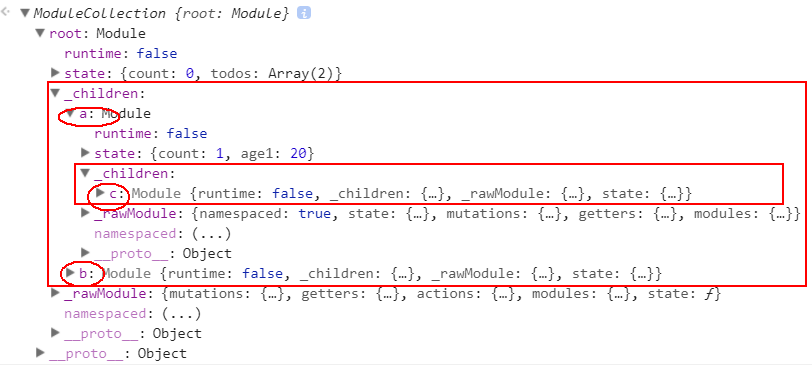第三章 ModuleCollection类
ModuleCollection类定义在VUEX源码的169 ~ 251 行,我们来具体看看它的内容。
3.1 成员属性
Module类的成员属性只有1个:
- root。挂载着根模块。
它并不是直接在构造函数中显示定义的,而是在原型函数register中定义的。通过在构造函数中调用register函数从而在成员属性root上挂载根模块。其实现在VUEX源码的192 ~ 214 行:
ModuleCollection.prototype.register = function register (path, rawModule, runtime) {
var this$1 = this;
if ( runtime === void 0 ) runtime = true;
{
assertRawModule(path, rawModule);
}
var newModule = new Module(rawModule, runtime);
if (path.length === 0) {
this.root = newModule;
} else {
var parent = this.get(path.slice(0, -1));
parent.addChild(path[path.length - 1], newModule);
}
// register nested modules
if (rawModule.modules) {
forEachValue(rawModule.modules, function (rawChildModule, key) {
this$1.register(path.concat(key), rawChildModule, runtime);
});
}
};
3.2 原型函数
3.2.1 ModuleCollection.prototype.get方法
get方法定义在VUEX源码的174 ~ 178 行,get方法主要是根据给定的模块名(模块路径),从根store开始,逐级向下查找对应的模块找到最终的那个模块,它的核心是采用的reduce函数来实现的,我们来看看它的源码:
ModuleCollection.prototype.get = function get (path) {
return path.reduce(function (module, key) {
return module.getChild(key)
}, this.root)
};
3.2.2 ModuleCollection.prototype.getNamespace方法
getNamespace方法定义在VUEX源码的180 ~ 186 行,getNamespace方法同样是根据给定的模块名(模块路径),从根store开始,逐级向下生成该模块的命名空间,当途中所遇到的模块没有设置namespaced属性的时候,其命名空间默认为空字符串,而如果设置了namespaced属性,则其命名空间是模块名+反斜线(/)拼接起来的字符。我们来看看它的源码实现:
ModuleCollection.prototype.getNamespace = function getNamespace (path) {
var module = this.root;
return path.reduce(function (namespace, key) {
module = module.getChild(key);
return namespace + (module.namespaced ? key + '/' : '')
}, '')
};
3.2.3 ModuleCollection.prototype.update方法
update方法定义在VUEX源码的188 ~ 190 行,用于从根级别开始逐级更新模块的内容:
ModuleCollection.prototype.update = function update$1 (rawRootModule) {
update([], this.root, rawRootModule);
};
它实际调用的是定义在VUEX源码224 ~ 251 行的全局update方法:
function update (path, targetModule, newModule) {
{
assertRawModule(path, newModule);
}
// update target module
targetModule.update(newModule);
// update nested modules
if (newModule.modules) {
for (var key in newModule.modules) {
if (!targetModule.getChild(key)) {
{
console.warn(
"[vuex] trying to add a new module '" + key + "' on hot reloading, " +
'manual reload is needed'
);
}
return
}
update(
path.concat(key),
targetModule.getChild(key),
newModule.modules[key]
);
}
}
}
这个方法会调用指定模块(第二个参数)的update方法,我们在第二章介绍过,每个Module实例都有一个update原型方法,定义在132 ~ 143行,这里再一次粘贴如下:
Module.prototype.update = function update (rawModule) {
this._rawModule.namespaced = rawModule.namespaced;
if (rawModule.actions) {
this._rawModule.actions = rawModule.actions;
}
if (rawModule.mutations) {
this._rawModule.mutations = rawModule.mutations;
}
if (rawModule.getters) {
this._rawModule.getters = rawModule.getters;
}
};
回到全局update方法,当判断出它还有子模块的时候,则会递归地调用update方法进行模块更新对应子模块。
3.2.4 ModuleCollection.prototype.register方法
register方法定义在VUEX源码的192 ~ 214 行,它主要是从根级别开始,逐级注册子模块,最终的模块链条会挂载在ModuleCollection实例的成员属性root上,我们来看看它的源码:
ModuleCollection.prototype.register = function register (path, rawModule, runtime) {
var this$1 = this;
if ( runtime === void 0 ) runtime = true;
{
assertRawModule(path, rawModule);
}
var newModule = new Module(rawModule, runtime);
if (path.length === 0) {
this.root = newModule;
} else {
var parent = this.get(path.slice(0, -1));
parent.addChild(path[path.length - 1], newModule);
}
// register nested modules
if (rawModule.modules) {
forEachValue(rawModule.modules, function (rawChildModule, key) {
this$1.register(path.concat(key), rawChildModule, runtime);
});
}
};
我们来过一遍该代码,这段代码首先保存了this副本:
var this$1 = this;
然后会判断runtime参数是否传递,如果没有传递,则会给它默认设置为ture:
if ( runtime === void 0 ) runtime = true;
{
assertRawModule(path, rawModule);
}
这里有一个小知识点是采用void 0 判断undfined,这是一种很好的方法,具体原因可以参考本人的这篇文章“JavaScrip中如何正确并优雅地判断undefined”。接下来会实例化一个Module,对于根Module而言,它会被挂载到ModuleCollection实例的root成员属性上,而对于子模块,它会找到它的父模块,然后挂载到父模块的_children属性上,由Module类我们知道,每一个模块都会有一个_children属性,用于存储它的子模块:
var newModule = new Module(rawModule, runtime);
if (path.length === 0) {
this.root = newModule;
} else {
var parent = this.get(path.slice(0, -1));
parent.addChild(path[path.length - 1], newModule);
}
最后面的代码就是递归的调用register函数用来执行前面几个步骤:
// register nested modules
if (rawModule.modules) {
forEachValue(rawModule.modules, function (rawChildModule, key) {
this$1.register(path.concat(key), rawChildModule, runtime);
});
}
那么register函数是在哪里调用的呢?它是在VUEX源码169 ~ 172行ModuleCollection的构造函数中调用的,我们来看看:
var ModuleCollection = function ModuleCollection (rawRootModule) {
// register root module (Vuex.Store options)
this.register([], rawRootModule, false);
};
我们可以通过一个例子来直观地看一看:
const moduleC = {
namespaced: true,
state: { count: 1, age1: 20 },
mutations: {
increment (state) {
// 这里的 `state` 对象是模块的局部状态
state.count++
}
},
getters: {
doubleCount (state) {
return state.count * 2
}
}
}
const moduleA = {
namespaced: true,
state: { count: 1, age1: 20 },
mutations: {
increment (state) {
// 这里的 `state` 对象是模块的局部状态
state.count++
}
},
getters: {
doubleCount (state) {
return state.count * 2
}
},
modules: {
c: moduleC
}
}
const moduleB = {
namespaced: true,
state: { count: 1, age1: 20 },
mutations: {
increment (state) {
// 这里的 `state` 对象是模块的局部状态
state.count++
}
},
getters: {
doubleCount (state) {
return state.count * 2
}
}
}
var options = {
state() {
return {
count: 0,
todos: [
{ id: 1, text: '...', done: true },
{ id: 2, text: '...', done: false }
]
}
},
mutations: {
increment (state) {
state.count++
},
increment1 (state) {
state.count++
}
},
getters: {
doneTodos: state => {
return state.todos.filter(todo => todo.done)
}
},
actions: {
increment (context) {
context.commit('increment')
}
},
modules: {
a: moduleA,
b: moduleB
}
}
var moduleCollectionIns = new ModuleCollection(options)
console.log(moduleCollectionIns)
输出结果:

3.2.5 ModuleCollection.prototype.unregister方法
unrigister方法定义在VUEX源码的216 ~ 222 行,它用于取消注册某个模块:
ModuleCollection.prototype.unregister = function unregister (path) {
var parent = this.get(path.slice(0, -1));
var key = path[path.length - 1];
if (!parent.getChild(key).runtime) { return }
parent.removeChild(key);
};
当取消注册某个模块时需要先拿到该模块的父模块,然后在父模块的_children对象中删除该模块,调用的是父模块的removeChild方法。这里面会判断待取消模块是否处于运行时(runtime),当不处于运行时(runtime)时可以取消注册。